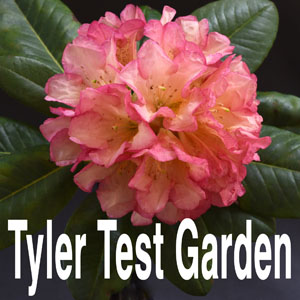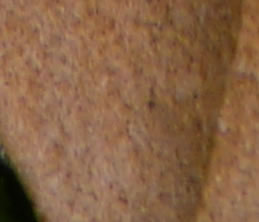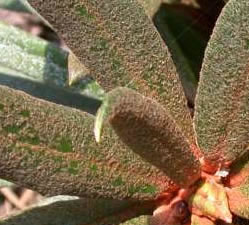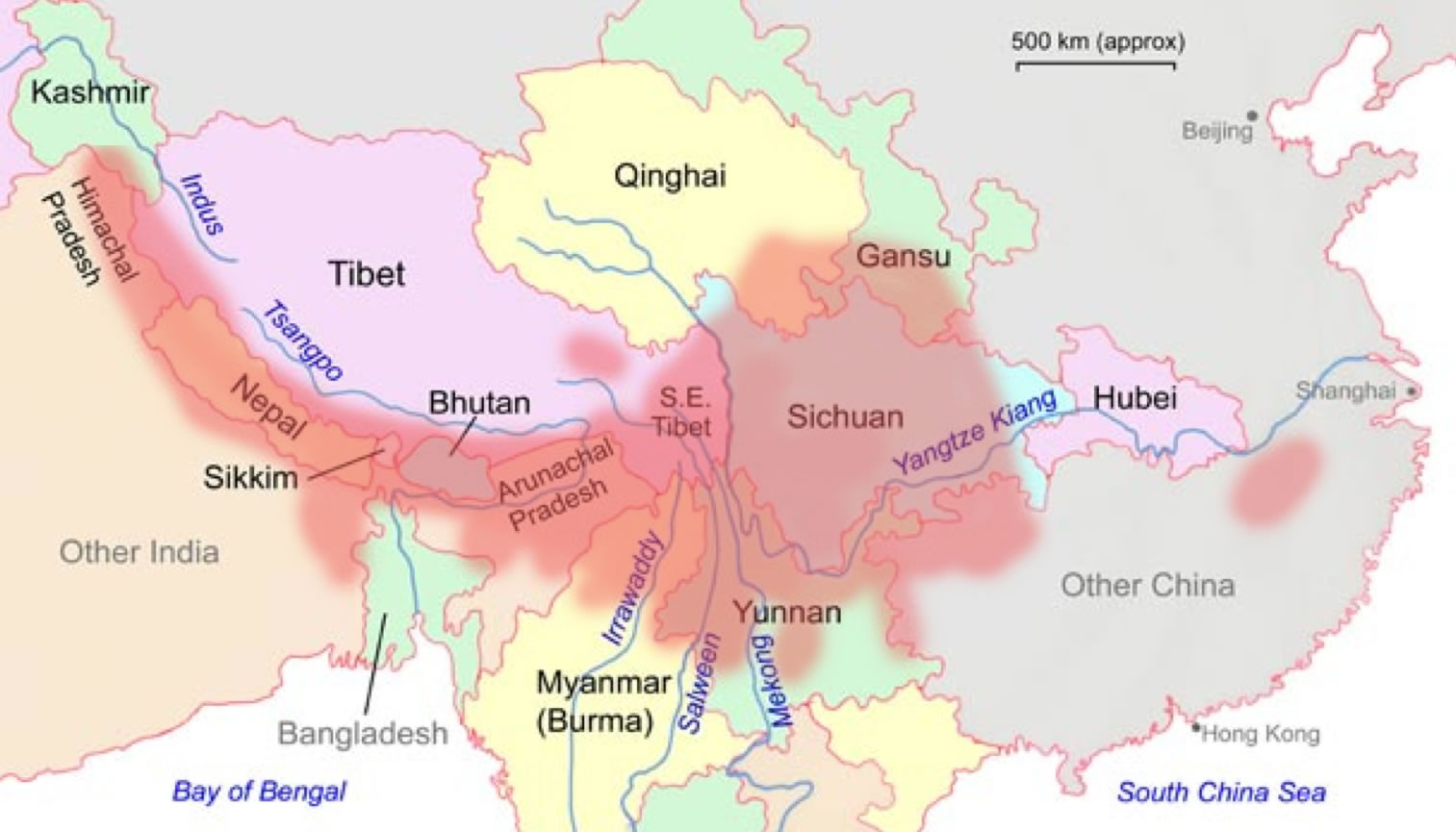
Elepidote Rhododendrons
Elepidotes
The elepidote rhododendrons don't have leaf scales and are generally the large-leaved species. Azaleas are among the elepidotes even though they usually have small leaves. For the purpose of this website, azaleas will be treated separately since they are very different from other elepidotes. Those rhododendron which are not elepidotes are lepidotes (have scales). Lepidotes include the tropical vireya rhododendrons.
Elepidotes
| Subgenus |
Members |
| Azaleastrum |
45 evergreen azaleas
6 deciduous azaleas
|
| Choniastrum |
5 elepidote species |
| Hymenanthes |
199 elepidotes &
20 deciduous azaleas |
| Therorhodion |
2 elepidote species |
The subgenus Hymenanthes contains about 219 species. They occur in southern Europe, the Caucasus Mountains, eastern and western North America, but the greatest diversity by far occurs in the region of rugged mountains and to a lesser extent in central and southeastern China. The elepidote rhododendrons are very uniform in their essential botanical characteristics. The subgenus Hymenanthes species are what most gardeners would think of as 'typical' or 'true' rhododendrons, for they far outnumber the lepidote rhododendrons in cultivation and, because of their greater bulk, they are more conspicuous. But it is the lepidote species R. ferrugineum, the alpine rose, that botanists use to anchor or centralize the defining features of the genus Rhododendron.
A further distinction, which distinguishes elepidotes from other members of the genus, is that the non-glandular hairs on the leaves and stems are, with few exceptions, branched and often of elaborate structure. In many species these hairs form a dense coating on the underside of the leaf, the nature of which depends on the structure of the hairs and their density. When conspicuous, these hairs are called indumentum and tomentum.
Return to Top
Indumentum and Tomentum
 |
Wooly Indumentum on the underside of a R. hodgsonii leaf |
 |
Persistent Tomentum on the topside of R. roxieanum leaves. |
Indumentum (pl. indumenta) is a general term denoting the covering of hairs found on the underside of the leaves of many rhododendrons. On rhododendrons, indumentum is commonly a woolly covering on the underside of mature leaves, while a similar surface on the upper side of leaves is called tomentum. Indumentum and tomentum are not unique to elepidotes, but are much more common on elepidotes. Rhododendrons with indumentum typically do not have scales and are hence elepidotes. Some lepidotes, such as R. edgeworthii, also have indumentum which may obscure the scales leading them to be mistaken for elepidotes occasionally. Technically, botanists consider indumentum and scales as a type of trichome.
A type of indumentum is plastered indumentum in which the hairs are flattened and somewhat shiny in appearance. A type of tomentum that remains on a leaf to maturity is persistent tomentum.
Indumentum and tomentum are much finer than human hair with some of the larger types being approximately 1/10 the size of human hair. Here are some examples of different types of indumentum and tomentum drawn in correct scale to each other:
Papillae: Members of the Boothii, Glaucum, and Maddenii Series and some members of the Fortunei and Thomsonii Series. (i.e. R. pubescens)
Filiform Hairs: Some members of the Triflorum and Scabrifolium Series have silky filiform hairs. (i.e. R. yunnanense & augustinii)
Acicular Hairs: Some members of the Scabrifolium and Stamineum Series. (i.e. R. spiciferum, scabrifolium championae, and tutcherae)
Loriform Hairs: Some members of the Maddenii, Boothii, Glaucum, Scabrifolium, and Edgeworthii Series. (i.e. R. moupinense)
Strigose Hairs: These are common on members of the Azalea, Albiflorum, Camtschaticum, Ovatum, and Semibaratum Series.
Setose Hairs: Some members of the Barabatum and Stamineum Series. (i.e. R. glischrum, auriculatum, championae, & tutcherae)
Simple Glands: On many species. (R. coryanum, griersonianum, mucronatum, smithii, planetum, agapetum, hemidartum, & degronianum)
Rosulate Hairs: On many members of the Grande, Argyrophyllum, Sanguineum, Arboreum, and Haematodes Series. (i.e. R. sinogrande, giganteum)
Cup-Shaped Hairs: On some members of the Falconeri Series. [Return to Top]
Radiate Hairs: Some members of the Ponticum and Lacteum Series. (i.e. R. lacteum, beesianum, colletum, traillianum, aberrans, & brachycarpum)
Long-Rayed Hairs: Some members of the Lacteum and Taliense Series. (i.e. R. wightii, mimetes, pratii, russotinctum, tritifolium & wasonii)
Vesticular Hairs: Some members of the Barbatum Series. (i.e. R. vesiculiferum)
Stellate Hairs: Some members of the Irroratum Series. (i.e. R. venator, facetum, & agapetum)
Dendroid Hairs: In all members of the Arboreum Series and some members of the Campanulatum, Grande, Neriiflorum, Ponticum, and Fulvum Series.
Flagellate Hairs: In the species R. longesquatum.
Folioliferous Hairs: In members of the Barbatum and Fortunei Series. (i.e. R. maculiferum, pachytrichum, & sutchuenense) [Return to Top]
Fasciculate Hairs: Members of the Campanulatum, Taliense, and Thompsonii Series. (i.e. R. fulgens, wallichii, paradoxum, wiltonii, & hookeri)
Capitellate Hairs: Form a suede-like indumentum on the species R. fulvum.
Ramiform Hairs: On some members of the Taliense, Barbatum, Caucasicum, and Neriiflorum Series. (i.e. R. bureavii, taliense, & smirnowii)
Funnel-Shaped Hairs: On some members of the Falconeri Series.
Return to Top
Map of Native Habitats of Elepidote Rhododendrons in SE Asia

Elepidote Rhododendrons are also found in Southern Europe, the Caucasus Mountain region bounded by Russia on the north and Turkey and Iran to the south, and the mountains of eastern and western North America.
[Return to Top]
Examples of Elepidote Rhododendron
Species
Subsection Arborea - R. arboreum
Subsection Campanulata - R. campanulatum and R. wallichii
Subsection Campylocarpa - R. campylocarpum, R. souliei and R. wardii
Subsection Falconera - R. falconeri, R. galactinum, R. rex and R. semnoides
Subsection Fortunea - R. decorum, R. fortunei, R. griffithianum and R. orbiculare, R. vernicosum
Subsection Grandia - R. grande, R. macabeanum and R. sinogrande
Subsection Neriiflora - R. catacosmum, R. haematodes, R. microgynum, R. sanguineum and R. sperabile
Subsection Pontica - R. aureum, R. degronianum, R. hyperythrum and R. ponticum
Subsection Taliensia - R. bureavii, R. mimetes, R. roxieanum and R. taliense
Subsection Thomsonia and Subsection Williamsiana - R. cerasinum, R. thomsonii and R. williamsianum
Return to Top
Subsection Arborea
Subsection Arborea has some of the tallest species.
R. arboreum – 6' +10F. It is a tall species with great long veined-leaves with indumentum. It has flowers that are white to red. Older specimens are actually grow into trees. It is native to the lower slopes of the Himalayas from Kashmir in the west to Bhutan in the east. Occurs at elevations of 4,000 to 9,000 ft. where it is often the dominant species.
R. arboreum 'Bhutan' – 6' +10F. It is a pink form from Bhutan. Most forms are reddish.
R. arboreum ssp. cinnamomeum – 6' +10F. It has flowers that are white to red. It is found at higher elevations than ssp. arboreum and thus generally hardier. Native to open forests and rocky slopes from 8,000 to 13,000 ft. in E Nepal and NE India (Bengal and Sikkim).
R. arboreum ssp. cinnamomeum var. roseum – 6' +10F. It is a pink form. Most forms are reddish. [Return to Elepidote Rhododendron Species Index]
Subsection Campanulata
Subsection Campanulata members have indumentum. Some are not heat tolerant.
R. campanulatum ssp. campanulatum – 4', -5F. It is a variable species ranging in habit from compact shrubs to small trees. The foliage is usually quite attractive with a dense fawn to brownish indumentum on the underside. The flowers are white to rose-pink or rose-purple. It is widespread and common, occurring from Kashmir to Sikkim in a wide variety of habitats from 9,500 to 13,500 ft.
R. campanulatum var. 'Graham Thomas' – 4', -5F. It has large flowers.
R. campanulatum 'Waxen Bell' – 4', -5F. It has small flowers.
R. wallichii – 4', -5F. It has deep to pale mauve, pink or purple flowers.. Although closely related to R. campanulatum it has a sparse dark brown indumentum on the undersides of the leaves. It grows in mixed forests of birch, spruce, and fir, or on open rocky slopes among scrub and juniper from 9,000 to 14,000 ft. from E Nepal to W Arunachal Pradesh and S Tibet. [Return to Elepidote Rhododendron Species Index]
Subsection Campylocarpa
Subsection Campylocarpa members need good drainage.
R. campylocarpum – 4', 0F. It has a reddish basal blotch. It is very similar to the closely related R. wardii. It is native to E Nepal, Sikkim, Bhutan, and from Arunachal Pradesh to SE Tibet, China, in mountain habitats from 9,000 to 14,000 ft.
R. souliei – 5', -5F. It has pink to white flowers. Peter Cox says “This superb plant is perhaps my favorite species”. It needs cool summers with excellent drainage. It is native to C & SW Sichuan in mountain habitats from 9,000 to 14,000 ft.
R. wardii var. puralbum – 4', 0F. It is a white cultivar.
R. wardii var. wardii – 4', 0F. It has yellow to sulfur-yellow flowers with a maroon or purple basal blotch. It is a parent to many beautiful yellow-flowered hybrids. It is native to SW Sichuan, NW Yunnan, and SE Tibet, China, in mountain habitats from 9,000 to 14,000 ft. [Return to Elepidote Rhododendron Species Index]
Subsection Falconera
Subsection Falconera all have indumentum.
R. falconeri – 4', +5F. It grows up to 80 ft. tall in the wild. These great large leaves can be up to one foot in length. The flowers range in color from white to pale yellow and have a purplish blotch. It is native in W & NW Yunnan, SE Tibet, to NE Burma in forests from 10,000 to 14,000 ft.
R. galactinum – 4', +5F. It is a rare “big-leafed” species and the hardiest in this subsection. It has leaves up to nine inches long. The flowers are white to rose. It is native to woodlands in C & W Sichuan, China from 7,500 to 10,800 Ft.
R. rex ssp. fictolacteum – 3', -5F. It can grow up to 45 ft. tall in the wild with leaves up to one foot in length. It has white to pale rose flowers. It is a common species from 10,000 to 14,000 ft. in forests of W Yunnan, China, SE Tibet and N Burma.
R. semnoides – 6', -5F. It is probably a natural hybrid but it illustrates the dense indumentum. It is found in NW Yunnan and adjacent SE Tibet from 12,000 to 13,000 ft. [Return to Elepidote Rhododendron Species Index]
Subsection Fortunea
Subsection Fortunea are found in a wide area in the Eastern Himalayas.
R. decorum – 5', 0F. It has large fragrant flowers that vary from white to pink. It is common in the wild and is drought tolerant. It is native from Sichuan, Yunnan to N Burma from 6,000 to 13,000 ft.
R. fortunei ssp. fortunei – 6', -10F. It has fragrant flowers that vary from white to pink. It is the hardiest of the fragrant species and is frequently used in hybridizing. It is one of the most widely distributed Chinese species. It is usually found between 2,000 and 3,000 ft.
R. griffithianum – 6', +15F. It is a distinct tall species with attractive peeling bark. Its leaves can be up to one foot in length. The flowers are pure white to rose and very large. It is a parent of the Loderi series of hybrids. It is native to forests from E Nepal to NE India from 6,000 to 9,500 ft.
R. orbiculare ssp. orbiculare – 3', 0F. It has flowers that vary from pink to magenta. It grows in coniferous forests and rocky thickets from W Sichuan to NE Guangzi from 7,000 to 13,000 ft.
R. vernicosum – 4', -10F. It is hardy enough for mild coastal regions in the eastern USA. It is native from Yunnan, Sichuan, and SE Tibet to Gangsu from 9,000 to 14,000 ft. in a wide variety of habitats. [Return to Elepidote Rhododendron Species Index]
Subsection Grandia
Subsection Grandia members have spectacular large leaves with indumentum. They are found in a wide area of the Eastern Himalayas.
R. grande – 5', +15F. It is a massive plant with leaves up to 18 inches in length. In the wild they often attain 50 ft. in height. The flowers range in color from white to yellowish with purple nectar pouches. It is native to forests from 7,000 to 10,500 ft. from E Nepal through Sikkim and Bhutan to Arunachal Pradesh.
R. macabeanum – 5', +10F. It is a tall plant that grows up to 45 ft. tall with large leaves 12 or even 18 inches long. It has huge flowers that are yellowish-white with a purple blotch. It is native to NE India (Manipur and Nagaland) where it occurs in mixed woodlands or forms pure stands from 8,000 to 10,000 ft.
R. sinogrande – 5', +10F. It has the largest leaves of any rhododendron. They can reach almost three feet in length! The flowers are white to pale yellow with a large crimson blotch. It is common and widespread from W Yunnan, China westward to N Burma, SE Tibet and E Arunachal Pradesh, India. Found in a variety of mountain habitats but principally in forests from 7,000 to 11,000 ft. [Return to Elepidote Rhododendron Species Index]
Subsection Neriiflora
Subsection Neriiflora members all have indumentum.
R. catacosmum – 4', 0F. It is scarlet red. It is native to the NW Yunnan/SE Tibet border.
R. haematodes ssp. haematodes – 3', -5F. It is a good garden plant. It is native to W & NW Yunnan from 11,000 to 13,000 ft.
R. microgynum – 2', 0F. It is deep crimson red. It is native to the NW Yunnan/SE Tibet border.
R. sanguineum – 3', 0F. Its flowers are vary in color, from deep blackish crimson to yellow or white. It is native to NW Yunnan & SE Tibet from 10,000 to 14,500 ft.
R. sperabile var. weihsiense – 3', 0F. It is bright red. It is native to cliffs & rocky slopes in NW Yunnan. [Return to Elepidote Rhododendron Species Index]
Subsection Pontica
Subsection Pontica. None of the Pontica are native to the Himalayan region.
R. aureum – 1', -15F. It is a dwarf shrub. It is unusual, a dwarf “alpine” elepidote. It is native over a wide area of N Asia including Siberia, N China and N Japan.
R. degronianum ssp. heptamerum – 3', -10F. It has thick indumentum. It is native to S Japan.
R. hyperythrum – 3', -10F. It is a compact shrub with white flowers with reddish flecks. It has good cold and heat tolerance. It will grow in the southeastern United States. It is native only to N Taiwan.
R. ponticum – 4', -5F. It is a tough and adaptable species that was formerly used as grafting rootstock. R. ponticum 'Variegatum' has variegated foliage with white streaks and purplish flowers. It is native from Spain & Portugal to SW Russia and Lebanon. [Return to Elepidote Rhododendron Species Index]
Subsection Taliensia
Subsection Taliensia members all have indumentum.
R. bureavii – 4', -10F. It has flowers that vary from white to pink spotted with purple or crimson. The foliage scorches in hot sunny exposures. It is native to N Yunnan, China where it occurs from 10,000 to 12,750 ft. in forests, rhododendron thickets and open alpine slopes
R. mimetes – 3', -10F. It is noted for its leaves which twist. It has a delicate pink flowers. It is found in SW Sichuan from 11,000 to 12,000 ft.
R. roxieanum – 3', -10F. It has very attractive foliage. The flowers are white or cream. It is native over a wide range of NW Yunnan, SW Sichuan and adjacent SE Tibet where it occurs in mountain habitats from 11,000 to 14,000 ft.
R. taliense – 4', -10F. It has flowers that are white with reddish spots. The foliage is fragrant on a warm day. It is native to W Yunnan, China where it occurs on open slopes from 10,000 to 13,000 ft. [Return to Elepidote Rhododendron Species Index]
Subsection Thomsonia and Subsection Williamsiana
Subsection Thomsonia members have little or no indumentum.
R. cerasinum – 3', 0F. It has crimson to scarlet flowers with purple nectaries. It is native to NE India, N Burma and SE Tibet where it occurs along streams, in dense thickets and in coniferous forests from 10,000 to 12,000 ft.
R. thomsonii ssp. thomsonii – 5', +5F. It has attractive peeling bark. The flowers are dark shades of red with a brightly colored calyx. The leaves are very round in shape. It is found E Nepal to Arunachal Pradesh in mountain habitats from 8,000 to 14,000 ft. in the eastern Himalayas.
Subsection Williamsiana has a single species.
R. williamsianum – 2', -5F. It is low with distinct round leaves. The flowers are light pink to rose and bell shaped. Williamsianum is native to a limited mountainous area in C Sichuan, China where it grows on high cliffs from 8,000 to 10,000 ft.
R. williamsianum Special– 2', -5F. It is a soft pink selection. [Return to Elepidote Rhododendron Species Index]
[Return to Top]
How
To Grow Rhododendron Species
Rhododendrons grow best in partial shade, since full sunlight tends to bleach the flowers. They need an acid soil with a pH of 5.0 to 6.0, well mulched with organic material. Mix garden loam with equal parts of coarse sand and ground bark or oak leaves before planting. Soil around the rhododendrons' shallow roots must be kept cool and moist but well drained. All except leather-leaf rhododendrons transplant well in the spring, or in the fall if mild winter weather does not damage the shallow-rooted plants. Do not fertilize at the time of planting, as this might injure the roots, but water deeply. Supplemental feeding later is not normally needed, but if a plant appears pale or droopy, apply cottonseed meal or a fertilizer for acid-loving plants around its base in early spring. A year-round mulch of rotted oak leaves will also provide natural nutrients and will help keep the soil cool and moist.
Prune rhododendrons after the flowers have faded to induce new growth. Most evergreen rhododendrons may be propagated from stem cuttings of new growth taken in late summer and rooted in a mixture of perlite or vermiculite and peat moss. Deciduous rhododendrons are propagated by seed, grafting or cuttings. For deciduous azaleas, cuttings may need bottom warmth of 75° and artificial light to promote root growth.
Do not cultivate around the shallow roots of rhododendrons and azaleas, but pinch off their faded flowers to improve bloom the following year. Also, prune out dead, diseased or damaged branches, and cut old branches back to the soil level to encourage new growth.
[Return to Top]
Directory of Contents for Henning's Rhododendron & Azalea Pages
•• Providing Information about the Genus Rhododendron since 1996
••
Articles Published by the American Rhododendron Society
Return to Top

Last Updated:
July 6, 2020
|